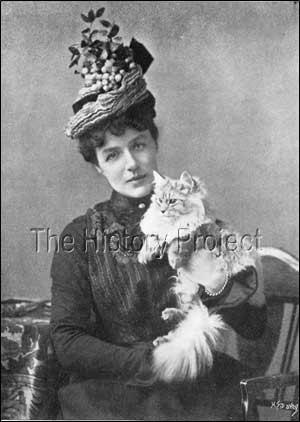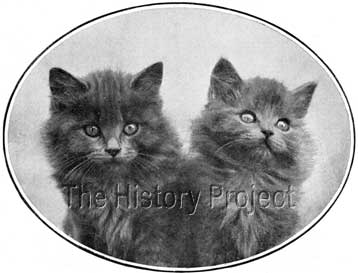 | |||||||||||||||









|
FRANCES A. SIMPSON (1857-1926)OLD & NEW INTERESTSWith the end of the Victorian era and the beginning of the Edwardian era and a new century, many new changes were taking place in the Cat Fancy. Given that Frances was already a seasoned breeder and exhibitor, it is likely that she attended the impromptu assemblage of ladies and gentlemen on the second day of a four day show at the Alexandra Palace on June 15th, 1887 when the idea of forming a National Cat Club was first mooted.
Likewise she is likely to have been among the number when a formal meeting was called at the Crystal Palace on 18th October 1887 when the National Cat Club was duly formed, with Harrison Weir as its first President, and Miss Gresham as its first Secretary. With the resignation of Mr. Weir and Miss Gresham in 1890, they were duly succeeded by Mr. Louis Wain and Mr. J.W. Townsend. This took place at almost exactly the same time as Mr. A.A. Clarke, and Miss Frances Simpson were working to gain a separation in the classes for Blues, one for males and one for females. This was also when the National Cat Club instituted the first Studbook and Register and thereby became, in fact, the first National Registry to ever exist. The first volume of the Studbook dated from July 31st, 1890 and was produced in 1893, just one year before the famous Crufts Cat Show of 1894, where the blue Persian 'Ch. Wooloomooloo' was victorious.
This was a time of considerable change. Mr. Weir's beloved brother and a popular cat judge, John Jenner Weir, who had officiated at the very first Crystal Palace Cat Show of 1871, died within a week or two of officiating at the Crufts Show of 1894. By now also, the Silvers, through the many descendants of 'Ch. Silver Lambkin' were coming to the fore, so between the Blues and the Silvers, there was considerable expansion taking place on the show benches. This expansion also included a rise in the number of exquisite English shorthairs, with cats such as Mr. Charles Heslop's 'Ch. Xenophon', and Mrs. Collingwood's 'Ch. James II' and other notables reinforcing the rise in popularity of the humble domestic cat.
Frances was not immune to these changes, and natural inclination toward her beloved of 'Brownies' got a boost with the purchase in 1897, of her prized future Champion, 'Persimmon', from Mr. Charles Heslop. Then in 1898, Lady Marcus Beresford instituted the largest change within the fancy, a new National body, simply called 'The Cat Club'. This had arisen due to considerable dissatisfaction in some circles over the management style of the National Cat Club. So a division now occurred between the supporters of Mr. Louis Wain and the executive of the National Cat Club, (NCC) and the supporters of Lady Marcus Beresford and the newly instituted 'The Cat Club' (CC). This division, although initially disruptive, did however cause improvements to take place in the running of shows and one of the benefits for the Fancy created from it, was that it made those with specialty interests sit back and take stock, and within three years, this saw a proliferation of new specialty clubs, all of which then saw it as their duty to acknowledge and endorse the capabilities of specialty judges. In 1899, a new weekly magazine, Our Cats, became the first and only newspaper in the world devoted entirely to cats. And through this magazine, budding writers with long experience in cats, including Miss Frances Simpson, could now proffer advice to a new generation of cat fanciers. Breeders and exhibitors now had their own medium through which they could advertise their studs at service, the successes of their respective catteries and through the columns of which, they could air their personal opinions! And many of the authors of the day, such as Charles Lane, Charles House and Frances Simpson, all were able to promote their new works through the medium of its pages. Among the countless topical subjects on which Frances gave written advice, were things such as the most suitable types of ribbons to tie around the necks of exhibits, about pen decoration, about types of carriers used, and how they should be lined, the types of straps best suited, and advice on sending cats to stud and the care needed to keep cats warm. A notable and humorous anecdote is given by May Eustace, in 100 years of Siamese Cats (1978). "Very fashion conscious, and always caring for the need for warmth at times, she advised cat owners to make little jackets to wrap around a cat. It was not surprising that a cat owner, having read Miss Simpson's show notes with particular emphasis on the necessity for warmth, sent her little cat to Miss Simpson's stud attired as she herself described her: 'A little lady was sent to my stud the other day clothed in a very smart jacket, through which her front paws were placed and it was buttoned up to the neck. This puss had also, a pair of washleather boots on her back legs, so that her appearance was a little startling!"29
Also in 1899, Frances acquired a new feline love, with the purchase of her Chinchilla male 'Cambyses', sired by 'Mowgli' (a son of Ch. Silver Lambkin), and bred by Miss Chappell. It may be observed that Frances was very adept at successfully navigating that fine and politically charged line between the two National bodies, showing due consideration and respect to both, but along with others, supporting the notion that an independent register, kept by a third and independent party would be most beneficial to all breeders and exhibitors. Like many, she saw the errors made by both bodies in the manner in which cats were registered and re-registered ad hoc, with multiple name changes and very often without an adequate numbering system. A classic example of just that was with two Siamese cats that came into her possession. These two cats, both Chocolate Siamese, were latterly named 'Netherlands Tilu' and 'Netherlands Ma'.6 They were half-brother and half-sister, bred originally in England by Mrs. Sutherland, both sired by her 'Prince of Siam', 'Tilu' born 18th March 1897, out of 'Kinck' and 'Ma' born 1st August 1897 out of 'Musidora'. The cats then became the property of Miss Hester Cochran. 'Tilu's' original name was "Tibi" and this was changed to 'Windsor He' at the time he was changed from the ownership of Miss Cochran, to that of Lady Marcus Beresford. This name change is recorded in The Cat Club Register.5 It is presumed that 'Ma' was likewise transferred, although there is no mention of her, or her original name. While in the ownership of Lady Beresford, 'Windsor He' was duly advertised at stud, along with her other males that were made available publicly. Then from the records of the Beresford Cat Club6, we find that Frances Simpson was also listed as a former owner, so we must presume that the cats went from Lady Marcus Beresford to Miss Frances Simpson. Later, they then appear to have crossed the Atlantic, into the ownership of Mrs. Clinton Locke (Adele Locke), before finally reaching Mrs. W.F. Hofstra, in New York, registered as 'Netherlands Tilu' and 'Netherlands Ma'. Mrs. Hofstra, appears in the first Stud Book of the Cat Fanciers' Association as its President. In the record of their show wins, the male 'Nilu' picked up a second at Westminster in 1900, followed by a second at Chicago in 1901, which therefore sets the date of exportation at a time early in 1901. However at the Chicago Show of 1901, he was defeated in the Chocolate Siamese class by 'Ma', who went on to win 2nd Best Shorthaired Cat in Show!
With the turn of the new century came many more changes. Frances Simpson's connections with those abroad were strengthened and she began to act as an agent for American breeders seeking British bloodstock. With the passing of the elderly Queen Victoria, who had been a silent unobtrusive supporter of the cause of the Blue Persian, the flag of royal sponsorship passed firmly to the Queen's grand-daughter, HRH Princess Victoria of Schleswig-Holstein, who was a Patron of the National Cat Club and who was becoming a regular breeder/exhibitor with the establishment of her cattery at Cumberland Lodge.
<< Back | 1 | 2 | 3 | 4 | 5 | 6 | 7 | 8 | 9 | 10 | Next >>
|
||||||||||||||
Home | Cats | Gallery | Clubs | People | Artifacts | Articles | Updates | Contact Us ©The CFA Foundation, Inc and The Harrison Weir Collection
|
|||||||||||||||



